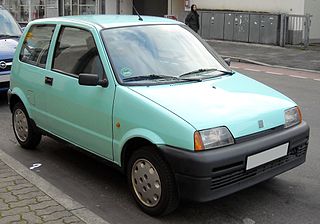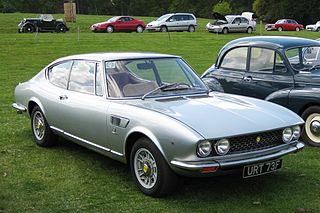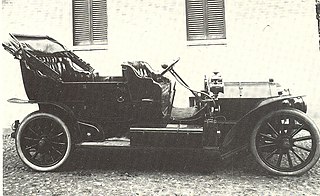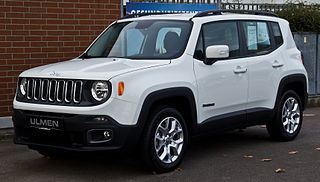
The Fiat 128 is a transverse front-engine, front wheel drive small family car manufactured and marketed by Fiat from 1969 to 1985 as a two- or four-door sedan, three- or five-door station wagon as well as two- or three-door coupé. The 128 running gear and engine, reconfigured for a mid-engined layout, were used in the Fiat X1/9 sports car.

The Fiat X1/9 is an Italian two-seater mid-engined sports car designed by Bertone and manufactured by Fiat from 1972–1982 and subsequently by Gruppo Bertone from 1982–1989.

The Fiat Croma name was used for two distinct large family cars by Fiat, one a five door liftback manufactured and marketed from 1985 to 1996, and after a nine-year hiatus, a crossover station wagon manufactured and marketed from 2004 to 2010.

The Fiat 500 is an economy / city car that was manufactured and marketed by Fiat Automobiles from 1957 until 1975. It was sold as a two-door semi-convertible or saloon car and as a three-door panel van or estate car.

The Fiat Panda is a city car manufactured and marketed by Fiat since 1980, currently in its third generation. The first generation Panda, introduced in 1980 as the Mk1, was a two-box, three-door hatchback designed by Giorgetto Giugiaro and Aldo Mantovani of Italdesign and was manufactured through 2003 — receiving an all-wheel drive variant in 1983. SEAT of Spain marketed a variation of the first generation Panda under license to Fiat, initially as the Panda and subsequently as the Marbella (1986–1998).

The Fiat Cinquecento is a front engine front-wheel-drive, four passenger, three door hatchback city car manufactured and marketed by Fiat from 1991 to 1998 over a single generation. It was manufactured at Fiat Auto Poland, which had manufactured its predecessor the Fiat 126.

The Fiat Dino was a front-engine, rear-wheel-drive sports car produced by Fiat from 1966 to 1973. The Dino name refers to the Ferrari Dino V6 engine, produced by Fiat and installed in the cars to achieve the production numbers sufficient for Ferrari to homologate the engine for Formula 2 racing.

The Alfa Romeo 164 is a four-door executive saloon manufactured and marketed by Italian automaker Alfa Romeo from 1987 to 1998, styled by Pininfarina, and cooperatively designed and sharing platforms and numerous elements with the Fiat Croma, Saab 9000 and Lancia Thema.

De Dion-Bouton was a French automobile manufacturer and railcar manufacturer, which operated from 1883 to 1953. The company was founded by the Marquis Jules-Albert de Dion, Georges Bouton, and Bouton's brother-in-law Charles Trépardoux.

The Fiat 131 is a mid-size family car manufactured and marketed by Fiat from 1974 to 1984 after its debut at the 1974 Turin Motor Show. Available as a two-door and four-door saloon and 5-door estate across a single generation, the 131 succeeded the Fiat 124.

The Fiat 600 is a small, rear-engined city car and economy family car made by Italian carmaker Fiat from 1955 to 1969 — offered in two-door fastback sedan and four-door Multipla mini MPV body styles. The 600 is considered a pop icon of the Italian economic miracle, and the three-row seating Multipla, though diminutive and odd-looking, is seen as one the first mass-produced minivans.

The Auto Avio Costruzioni 815 was the first car to be fully designed and built by Enzo Ferrari. Legal issues with former associates Alfa Romeo prevented Ferrari from creating the Ferrari marque. The 815 raced at the 1940 Brescia Grand Prix, where both entries failed to finish due to engine problems. One of the cars was later scrapped, while the other is currently in a car collection in Italy.

The Fiat 124 Sport Coupé is a two-door, four-seater notchback coupé produced by the Italian automaker Fiat in three generations between 1967 and 1975. It was based on the Fiat 124 saloon.

The Fiat 850 is a small rear-engine, rear-wheel-drive car manufactured and marketed by Italian car manufacturer Fiat from 1964 to 1973.

The Lancia Kappa or Lancia k is an executive car manufactured and marketed by Italian automaker Lancia from 1994 to 2000 in saloon, estate, and coupé body styles — sharing its platform with the Alfa Romeo 166. The Kappa has a front-engine, front-wheel-drive, five passenger, left-hand drive design.

The Fiat 518, also called Fiat Ardita, was a model of car produced by Italian car manufacturer Fiat between 1933 and 1938. The name "Ardita" was also used on the six-cylinder engined and more expensive Fiat Ardita 2500 or 527.

The Fiat 12 HP is a car produced by the Italian manufacturer Fiat in 1901 and 1902. The car was designed by the engineer Giovanni Enrico, successor to the Faccioli who had engineered the first three Fiat models, it was the first Fiat and one of the first cars of this era equipped with a two-block four-cylinder engines. It was manufactured in 106 copies in the plant Corso Dante. A racing version was also made the 12 HP 1901 Corsa which incorporated the same engine. The maximum speed was 78 kilometres per hour (48 mph). This car put an end to the domination of Panhard on European courses.

The Fiat 24-32 HP was introduced by the Italian automobile manufacturer Fiat in 1901. The car was designed to allow coachbuilders to make various bodies to fit. It was offered with three different wheelbases, short, medium and long.

The Jeep Renegade is a subcompact crossover SUV produced by Stellantis under their Jeep marque. It was first shown to the public in March 2014 at the Geneva Motor Show and production started in late August of that year. The Renegade was the smallest vehicle currently marketed by Jeep, until the arrival of the Avenger. It slots between the Avenger and the Compass. It is based on the FCA Small Wide 4×4 platform which is also shared with other FCA models, including from Fiat and Alfa Romeo brands.

The Fiat S76, later also known as Fiat 300 HP Record and nicknamed "The Beast of Turin", was a car built in 1910 by the Italian company Fiat specifically to beat the land speed record held in those years by the Blitzen Benz. Its 28,353 cc displacement engine delivered 290 hp. Only two examples were built.





















